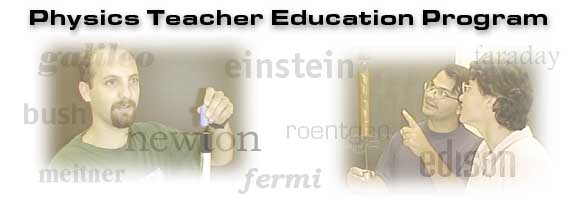 Realizing
the Democratic Ideal:
Teacher
Education at Illinois State University
Realizing
the Democratic Ideal:
Teacher
Education at Illinois State University
PHYSICS 413 --
TEACHING HIGH SCHOOL PHYSICS II
DEPARTMENT OF PHYSICS
Autumn Semester
2014
Drop
Down to Topic Outline
(Last updated 9/08/2014, cjw)
Catalog
Description:
413 TEACHING HIGH SCHOOL PHYSICS II 3 sem. hrs. Spring
Employs
goal setting, self-assessment, and instructional design as a way of improving
the physics teachers' inquiry practice.
Prerequisite: Open only to certificated, in-service high school
teachers of physics and physical science with a minimum of two years of teaching
experience. Approval of course instructor also required.
Instructor:
Class
Meetings:
This course will be taught on an independent basis with meetings as necessary.
Course
Overview:
The aim of this course is to provide in-service teachers of physics and/or
physical science with a mechanism for improving their professional practice.
The end in view is to help participating teachers move toward National Board Certification by working with the Board's Architecture of Accomplished Teaching, including the Five Core Propositions. The immediate goal is for teachers to: (1) know their students and their students' needs, (2) set high and worthwhile goals that satisfy the students' needs, (3) implement instruction to attain these goals, (4) evaluate student learning in light of these goals, (5) reflect on student learning and the effectiveness of instructional design, and (6) set higher goals that are appropriate to students at this time.
Policies: In this course emphasis will be placed on a Assessment-for-Learning
policy. That is, assessments of student performance will be used not only
to generate scores and assign a course grade, but also to improve student performance. Unsatisfactory
written work will be returned to the student for improvement, but only if
submitted by the deadline. A student's score can be improved by appropriate
revision and resubmission of unsatisfactory course projects, so long as all
deadlines are met. Each class will
consist of discussions of assigned readings, modeling and practicing of secondary-level
inquiry lessons
that demonstrate appropriate infusion of instructional technology, teacher
presentations, and activities related to increasing the understanding the
nature of scientific inquiry.
Required In-Service Teacher Tasks:
Self-Assessment
of Current Teaching Practice
(20%
of course grade)
Each in-service teacher will perform an evidence-based self-assessment of personal teaching
practice in relation to a specific set of inquiry practice indicators. The purpose of this task is to allow in-service teachers to reflect on their own teaching practice, to identify problems associated with that teaching practice that originate from within the teacher and from within the institutional setting, and as a means of examining significant performance problems associated with the instruction (classroom, school, district, state). This self-assessment must be completed an RTOP-based self assessment. See the instructor for a copy of this instrument.
Draft NBPTS-based Professional Teaching Portfolio (80% of course grade) Each in-service teacher will create a draft NBPTS-based professional teaching portfolio addressing four areas of the Science/Adolescence and Young Adulthood Standards and include additional sections as indicated below.
General portolio instructions contains information about the following topics:
- The Five Core Propositions
- Portfolio Overview
- Portfolio Guidelines and Considerations
- Studying the Standards
- Writing About Teaching
- Video Practice
- Preparing and Mailing Your Portfolio
- Portfolio and Eligibility Forms
Download General Portfolio Instructions as well as the specific AYA/Science Portfolio Instructions to learn more about the requirements for preparing, developing, and submitting the portfolio component of your assessment.
When preparing your portfolio, be certain to adhere to the page limits specified.
Course
Grade:
The
course grade for each student will be based upon the percentage of total points
generated on the student performance assessments, and will be assigned according
to the following system.
A > 94% 83% < B < 94% 72% < C < 83% 67% < D < 72% F < 67%
The
above grading scale might seem a bit high to the
in-service teacher
but it assumes that
students will take advantage of the instructor's Assessment-
for
-Learning policy.
References:
Aarons, A. B. (1997). Teaching Introductory
Physics, New York: John Wiley & Sons, Inc
American Association for the Advancement
of Science. (1993). Benchmarks for Scientific Literacy, F. James Rutherford
(ed.). Washington: Oxford University Press.
Center for Science, Mathematics, and Engineering
Education (2000). Educating Teachers of Science, Mathematics, and Technology:
New Practices for the New Millennium. Available: http://www.nap.edu/books/0309070333/html/
Hatton, J. & Plouffe, P. B. (1997). Science and Its Ways of Knowing. Upper Saddle River, NJ: Prentice Hall.
Kober,
N. (1993). EdTalk: What We Know About Science Teaching and Learning. Washington: Council for Educational Development and Research.
Lawson, A. E. (1995). Science Teaching
and the Development of Thinking. Belmont, CA: Wadsworth Publishing Company.
National Science Teachers Association (1994). Scope, Sequence, and Coordination. Washington: Author
National Research Council (1996). National
Science Education Standards. Washington, DC: Author.
National Research Council (2000). Inquiry
and the National Science Education Standards. Washington, DC: Author
National Research Council (2000). How People Learn. Washington, DC: Author.
National Science Teachers Association. (1993). Handbook of Research on Science Teaching and Learning, Dorothy L. Gabel
(ed.). New York: Macmillan Publishing Company.
Rensselaer Polytechnic Institute & National
Science Foundation (197x). Conference on the Introductory Physics Course, Jack Wilson (ed.), New York: John Wiley & Sons, Inc.
Rutherford, F. J. (1990). Science for
All Americans -- Project 2061, Washington, DC: American Association for
the Advancement of Science.
Swartz, C. E., & Miner, T. (1998). Teaching
Introductory Physics: A Sourcebook. New York: Springer-Verlag.

